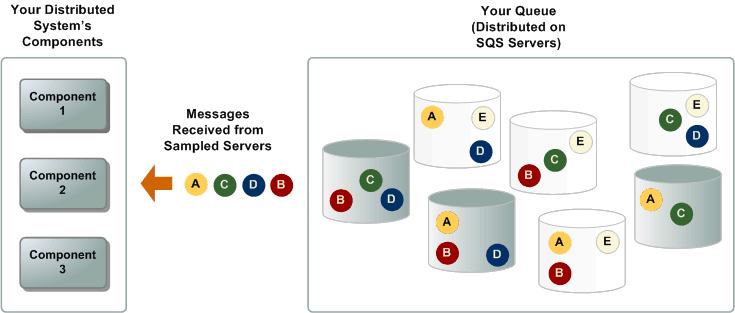Amazon SQS short and long polling
Amazon SQS offers short and long polling options for receiving messages from a queue. Consider your application's requirements for responsiveness and cost efficiency when choosing between these two polling options:
-
Short polling (default) – The
ReceiveMessagerequest queries a subset of servers (based on a weighted random distribution) to find available messages and sends an immediate response, even if no messages are found. -
Long polling –
ReceiveMessagequeries all servers for messages, sending a response once at least one message is available, up to the specified maximum. An empty response is sent only if the polling wait time expires. This option can reduce the number of empty responses and potentially lower costs.
The following sections explain the details of short polling and long polling.
Consuming messages using short polling
When you consume messages from a queue (FIFO or standard) using short polling, Amazon SQS
samples a subset of its servers (based on a weighted random distribution) and returns
messages from only those servers. Thus, a particular ReceiveMessage
request might not return all of your messages. However, if you have fewer than 1,000
messages in your queue, a subsequent request will return your messages. If you keep
consuming from your queues, Amazon SQS samples all of its servers, and you receive all of
your messages.
The following diagram shows the short-polling behavior of messages returned from a standard queue after one of your system components makes a receive request. Amazon SQS samples several of its servers (in gray) and returns messages A, C, D, and B from these servers. Message E isn't returned for this request, but is returned for a subsequent request.

Consuming messages using long polling
When the wait time for the ReceiveMessage API action is greater than 0, long polling
is in effect. The maximum long polling wait time is 20 seconds. Long polling helps reduce the cost of using Amazon SQS by eliminating the number of empty responses
(when there are no messages available for a ReceiveMessage request) and false
empty responses (when messages are available but aren't included in a response). For information about enabling long polling for a new or
existing queue using the Amazon SQS console, see the Configuring queue parameters using the Amazon SQS
console. For best practices, see Setting-up long polling in
Amazon SQS.
Long polling offers the following benefits:
-
Reduce empty responses by allowing Amazon SQS to wait until a message is available in a queue before sending a response. Unless the connection times out, the response to the
ReceiveMessagerequest contains at least one of the available messages, up to the maximum number of messages specified in theReceiveMessageaction. In rare cases, you might receive empty responses even when a queue still contains messages, especially if you specify a low value for theReceiveMessageWaitTimeSecondsparameter. -
Reduce false empty responses by querying all—rather than a subset of—Amazon SQS servers.
-
Return messages as soon as they become available.
For information about how to confirm that a queue is empty, see Confirming that an Amazon SQS queue is empty.
Differences between long and short polling
Short polling occurs when the WaitTimeSeconds parameter of a ReceiveMessage request
is set to 0 in one of two ways:
-
The
ReceiveMessagecall setsWaitTimeSecondsto0. -
The
ReceiveMessagecall doesn’t setWaitTimeSeconds, but the queue attributeReceiveMessageWaitTimeSecondsis set to0.